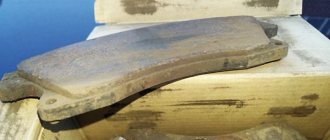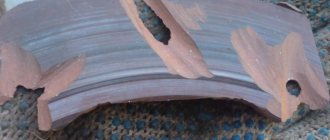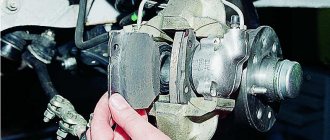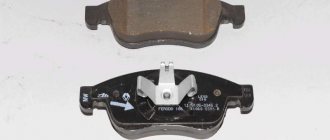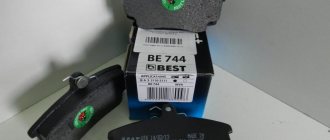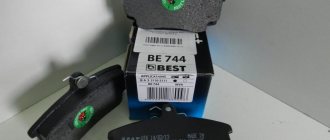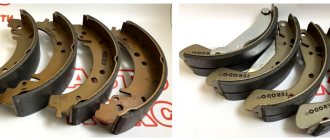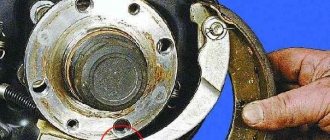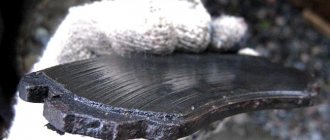Front pads 2101-3501090
The choice of brake pads for the VAZ 2107 is quite wide, starting from budget original options for 200-300 rubles. and ending with analogues from famous world brands with a price tag of under 1,500 rubles. per set. Therefore, it makes sense to take a closer look at the substitutes offered in online stores in order to select good brake pads for the VAZ 2107.
The front brake discs are equipped with pads with catalog number 2101-3501090. Their dimensions: length 83.9 mm, height 60.5 mm, thickness 15.5 mm. These pads are compatible with all models of the classic VAZ 2101-2107 family of cars. The supplier and manufacturer of original front brake pads for the VAZ conveyor is JSC TIIR.
Rear pads 2101-3502090
The rear drum-type pads have part number 2101-3502090. Size: 250 mm in diameter and 51 mm wide. Original rear pads are produced at AvtoVAZ OJSC. These pads are also suitable for VAZ 2101-2107 and for Chevrolet/NIVA 2121 cars. Rear drum pad linings with article number 2101-3502105 are also available for sale. Many car enthusiasts replace the linings themselves, but this procedure requires certain skills. Replacing the pads is much easier and anyone can do it.
PURPOSE AND TYPES OF BRAKE PADS
Friction is used to stop a car. In the case of the VAZ 2107, this is the friction force of the pads on the brake disc (or on the brake drum, if the pads are rear). In general, the block is a steel plate with mounting holes, to which an overlay is attached using rivets. This is a rectangular plate made of a special material with a very high coefficient of friction. If the friction coefficient of the lining decreases for some reason, braking becomes less effective. And this immediately affects the quality and safety of driving.
WHAT ARE THE PADS?
The designers of the VAZ 2107 provided two different braking schemes for the front and rear wheels of the “seven”.
FRONT PADS
To brake the front wheels, flat, rectangular paired pads are used. The front wheels of the “seven” are equipped with massive steel discs that rotate synchronously with the wheels. When braking, rectangular pads compress the rotating disc on both sides. After this, the friction force provided by the linings comes into play, and the discs and wheels stop.
The front pads of the “seven” are ordinary rectangular plates with overlays
The pad plates are installed in a special device called a caliper. This is a massive steel housing with several holes, which houses the above brake disc with a pair of pads. The movement of the pads is ensured by special pistons in the braking cylinders. Liquid is supplied to the cylinders under high pressure and the pistons extend from them. The rod of each piston is attached to the pad, so that the pads also move and compress the brake disc, stopping it along with the wheel.
REAR PADS
The rear pads on the “seven” have a fundamentally different design. If the front pads press on the disc from the outside, then the rear pads press from the inside, and not on the disc, but on the massive brake drum. For this reason, the rear pads are not flat, but C-shaped.
The rear brake pads of the “seven” are much longer than the front ones and have a C-shape
Each pad also has its own rectangular pad made of a special material, but the rear pads are much narrower and longer. These pads are also driven by cylinders, but they are double-sided cylinders, that is, the rods from such a cylinder can extend from both sides, so that it can move two brake pads at the same time. The pads are returned to their original position not by the rods (because they are not attached to the rods of the double-sided cylinder), but by a powerful return spring stretched between the pads. Here we should also mention the inner surface of the brake drums. Very serious requirements are placed on the quality of this surface. It's simple: the pads can be the best, but if the inner surface of the drum is worn out, if it is covered with cracks, scratches and chips, then braking will be far from ideal.
Cost of brake pads for VAZ 2107
The price of high-quality pads for a classic VAZ, of course, depends on the lining materials used, technological features and manufacturer.
| Front pads for VAZ 2107 | |||||
| Brand | TIIR (original) | Allied Nippon | AND THOSE | Ferodo | Finwhale |
| vendor code | 2101-3501090 | ADB 0281 | 13.0460-2966.2 | FDB 96 | V 211 |
| Price | 260 rub. | 340 rub. | 700 rub. | 430 rub. | 370 rub. |
| Rear pads for VAZ 2107 | |||
| Brand | VAZ (original) | TSN | ATE |
| vendor code | 2101-3502090 | TSN 2.3.1 | 03.0137-0232.2 |
| Price | 750 rub. | 500 rub. | 1240 rub. |
It should also be emphasized that there are now a lot of fake brake pads for such a popular car. Therefore, choose only trusted manufacturers and pay attention to the packaging, configuration and labeling on the products. For example, the Ferodo brand uses tape with red or blue stripes to seal a box of pads.
SIGNS OF WEAR PADS
Here are the most common signs that it’s time to change the pads urgently:
- a strong grinding or creaking sound that occurs when braking. Moreover, this sound may intensify with increasing pressure on the brake pedal. The reason is simple: the linings on the pads are worn out, and you have to brake not with the linings, but with bare steel plates. It is this braking that causes the loud grinding noise. Often only a small area of the lining wears out, but even this is enough for braking efficiency to drop several times. And uneven wear of the linings can occur due to the fact that the pads are installed with a slight distortion;
- A knocking sound that occurs when driving when the brakes are not used. As mentioned above, each pad has special pads. These pads are attached to the pads using rivets. Over time, the rivets wear out and fall off. As a result, the lining begins to dangle and knock. If you don't take action, it breaks. Very often, when removing an old block, the following picture is observed: a piece of the lining hangs from the block, dangling loosely on one surviving rivet.
What are the best pads to buy for the “seven”
And so, it is clear that you should not skimp on the reliability of the brakes, especially for a car designed in the middle of the last century and devoid of ABS and other bells and whistles to increase safety. Therefore, we recommend buying pads for the VAZ 2107 that best meet the following indicators:
- optimal friction coefficient both in “cold” mode and on warm brakes (0.35-0.45 according to GOST);
- high lining life and minimal wear of the brake disc.
- absence of uncomfortable sounds, creaks, vibrations when braking;
The last point is subjective, since the pads squeak due to the unsatisfactory condition of the brake system as a whole, disc wear, and poor caliper performance, which is also very important to consider when replacing brake pads on a VAZ 2107 yourself.
Under severe operating conditions (under heavy loads and sudden braking), choose solid pads from the following companies: ATE, Ferodo. For more moderate city driving, which does not involve frequent overheating and large constant loads on the brake system, buy “softer” pads - Allied Nippon, Finwhale, TIIR.
When purchasing, it is important to pay attention to the composition of the friction clutch; pads using large metal shavings, in the form of inclusions, can greatly wear out the disc, leaving grooves on it. It is best to buy pads with modern high-tech compounds that will protect the disc from premature wear.
IMPORTANT POINTS
There are a couple of important nuances that you need to remember when changing pads:
- Reinstalling one of the long bolts on the brake drum guard can cause serious problems. The fact is that there is not enough space behind the shield, and not everyone will be able to stick their fingers there. Experienced owners of “sevens” know this and do it simply: tie the bolt to a thread. The second end of the thread is tied to a piece of wire. This wire is inserted into the bolt hole, picked up with pliers on the other side of the shield and pulled out along with the thread and the long bolt;
One of the bolts on the brake shield is extremely difficult to install, since there is little space behind the shield - After installing the long bolt, be sure to check the fastening bolts of the shield itself. There are four of these bolts. And the nuts on these bolts are almost always loose. The nuts should be tightened, and the tightening torque should be at least 50 kgf/m;
There are four bolts on the brake flap that must be tightened - Special mention should be made of the brake drum. If, when examining the inner wall of the drum, at least one defect in the form of a scratch or dent was found on it, it must be eliminated. Under no circumstances should new pads be installed in a damaged drum. The only way to eliminate such defects is the so-called boring. The drum is fixed in a lathe and its inner surface is ground down to the depth of the defect. Usually this is no more than 2 mm. If the pothole on the drum is much deeper, then no one, even the most qualified turner, will be able to help, and the drum will have to be replaced.
When and how to change pads on a VAZ 2107
It is better to think about replacing brake pads not when the linings have already worn down to 1.5 mm, and the brake disc has developed to a minimum thickness of 9 mm, but to decide on the choice in advance.
On average, pads last 15-30 thousand. km. depending on driving style. The service life of the brake discs is enough for 2-3 sets of pads.
In order to independently replace the pads with new ones, this should be done for both front wheels at once, that is, as a set. To replace you will need:
- jack;
- wheel wrench for removing wheels;
- pliers;
- screwdriver.
After lifting the body with a jack, you need to secure the rear wheels and the body well with supports to safely remove the front wheel. Next, remove the wheel and check the condition of the brake system, measure the thickness of the disc in different places, and the thickness of the linings.
In order to remove the old pads, you must first pull out the cotter pins that secure the pins in the hub. Next, carefully knock the pins out of the hub with a small screwdriver; you can use WD-40 if they are stuck to the caliper lugs. After these manipulations, remove the springs that secure the pads, move the pistons apart and remove the old pads. More details about replacing the front and rear brake pads on a VAZ 2107 can be found in the video or in the article with step-by-step illustrations on our website!
Brake pad problems
The parts of the braking system in question have to be changed not only when they wear out, but also when malfunctions occur that are associated with the use of low-quality consumables or too active driving. The following characteristic signs indicate problems with the pads:
- creaking, grinding and other extraneous sounds when braking;
- car skidding when pressing the brake pedal;
- to operate the pedal you have to exert more or less force than usual;
- beating of the pedal when braking;
- after releasing the pedal, it does not return to its original position;
- the presence of black dust on the rims.
Extraneous sounds
Modern brake pads are equipped with special indicators that indicate wear of these car parts. The indicator is a metal strip that is attached below the friction lining. When most of the material is worn out, but the pad is still able to decelerate, a characteristic grinding or whistling sound appears when the brake pedal is applied. If the pads are not equipped with such indicators, the presence of extraneous sounds indicates obvious wear of the elements in the brake mechanism and the need to replace them.
Pad wear can manifest itself in different ways, and one of the signs is extraneous sounds when braking.
Skid
If the car skids to one side when braking, then the likely cause is wear on one of the pads. The car can skid until it turns around, even on a dry surface. In addition to the pads, skidding can occur due to scuffing or deformation of the brake discs.
Video: why the car pulls to the side when braking
Some time ago I was faced with a situation where the car began to pull to the side when braking. It didn't take long to find the reason for this behavior. After a quick inspection of the car's underside, it was discovered that one of the rear brake wheel cylinders was leaking. This caused brake fluid to get on the working surface of the pad and drum, as a result of which the mechanism was unable to perform its function. The problem was resolved by replacing the cylinder and bleeding the brakes. If you encounter a similar situation, I recommend replacing the entire cylinder rather than installing a repair kit, since the quality of rubber products today leaves much to be desired.
Increase or decrease pedal effort
If the pedal has to be pressed unusually hard or lightly, the problem may be caused by worn or dirty pads. If everything is in order with them, then you should check the integrity of the entire brake system for fluid leaks.
Vibration
If there is vibration when you press the brake pedal, then a possible reason is that dirt has gotten between the brake disc and the pads, or a crack or chips have appeared on the latter. As a result, parts are subject to premature wear. However, you should be aware that a similar phenomenon is also possible due to problems with the hub or hydraulic cylinders of the brake system.
The pedal goes down
Sometimes it happens that the brake pedal does not move back after being pressed. This indicates that the pads are “stuck” to the disc. This phenomenon can be observed at sub-zero temperatures when moisture gets on the pads. In addition, air may enter the braking system, which requires inspection and subsequent repair or bleeding of the brakes.
Plaque on discs
Plaque on wheel rims is black dust, which indicates wear on the pads. If the dust contains metal particles, then not only the pads are erased, but also the brake disc itself. If such a situation arises, you should not delay inspecting the brake mechanism, as well as replacing failed parts.
The appearance of black deposits on wheels can be caused by active driving or natural wear of the pads.
One day I noticed that the front wheel rims were covered with black dust, and it was not road dust. It is no longer known what brake pads were installed at that time, but after replacing them with factory ones from AvtoVAZ, the situation remained unchanged. Therefore, I came to the conclusion that the appearance of black dust is a normal phenomenon, indicating natural wear of the pads.
How to choose gaskets?
The appearance and markings of gaskets can tell a lot about them. In particular, the marking must indicate the coefficient of friction, designated by two letters (averaged during heating - the first letter, averaged after cooling - the second). Unfortunately, this is not always possible to find:
Source
The brake system of a car must always be in good technical condition, and this primarily applies to the brake pads. In the VAZ "Seven" they rarely have to be changed, and the main reason for this is wear of the friction lining. Problems with the brake mechanisms are indicated by appropriate signs indicating the need for inspection and repair or replacement of the brake elements.
READ What Engine is on the Ravon R4
Article number and cost of good front brake pads for VAZ 2107 from third-party manufacturers
When choosing which pads to put on the front axle of a VAZ 2107, the car owner should take the most responsible approach to the selection of consumables. They will bear the main force when stopping the car.
Original products produced by TIIR have mediocre quality and satisfactory performance characteristics, so there is an opinion among owners that it is better to supply an analogue. Recommended brake pads are shown in the table below.
Table - Good analogues of the original front pads
| Manufacturer | vendor code | Approximate cost, ruble |
| Ferodo | FDB96 | 560-670 |
| Road House | 208000 | 510-650 |
| TRW | GDB140 | 900-1100 |
| Delphi | LP92S | 240-300 |
| Shafer | SB20166 | 200-280 |
Where are the rear brake pads located?
If the car is fully equipped, that is, all the wheels will be in place, etc. You will practically not be able to see the rear pads, since they are located under the drum itself, or to be more precise, inside it, so in order for you to more or less be able to see the pads, then you will need to first remove one of the rear wheels and then remove the ram itself and only then will you see the brake pads in front of you.
